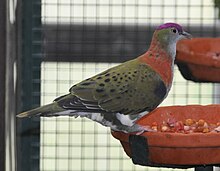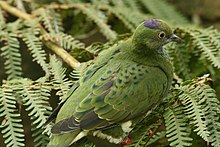Royal fruit pigeon
| Royal fruit pigeon | ||||||||||
|---|---|---|---|---|---|---|---|---|---|---|

Magnificent fruit pigeon, male |
||||||||||
| Systematics | ||||||||||
|
||||||||||
| Scientific name | ||||||||||
| Ptilinopus superbus | ||||||||||
| ( Temminck , 1810) |
The royal fruit dove ( Ptilinopus superbus ) is a species of pigeon birds. It is one of the particularly colorful fruit pigeons. It is distributed in several subspecies in Australasia .
Appearance
The royal fruit pigeon is a small fruit pigeon and reaches a body length between 24 and 28 centimeters. It is about the size of a laughing dove , but a bit more compact. Their tail is also a little shorter. It weighs an average of 125 grams. A gender dimorphism is present.
The males have a purple head cap. A wide orange band runs from the back of the neck to the sides of the neck. The throat is silver. The breast plumage is gray with lighter tips. The underbust is set off from the white belly by a blue ribbon. The belly sides are green with white spots. The top of the body is also green, but shimmers copper-colored. The wing covers have narrow yellow hems. The wings of the hand are black. The beak is olive colored at the base and brightens to a yellow at the tip. The iris is yellow. The feet and legs are reddish. The females are mostly green with a small blue-black patch on the back of the head. They lack the blue chest band.
distribution and habitat
The distribution area of the royal fruit pigeon is large and overlaps very much with that of the purple breasted fruit pigeon . It extends from Maluku over the islands of Numfoor and Japen, the Aru Islands , Sulawesi , New Guinea , the Bismarck Archipelago , the Solomon Islands over the Australian Cape York to New South Wales . The habitats of the royal pigeon are evergreen tropical deciduous forests as well as mangroves and plantations.
behavior
Like most fruit pigeon species, the licorice pigeon is a tree dwelling species. It feeds on small berries and fruits. Like many fruit pigeons, magnificent fruit pigeons also show a high level of climbing ability. Occasionally there is swarm formation. The nest is a small platform made of branches and is usually found at a low height in trees. The clutch consists of an egg.
Keeping in human care

Magnificent fruit pigeons were first shown at London Zoo in 1865. As with all downy pigeons ( Ptilinopus ), keeping them is very time-consuming and costly. They must be housed in a warm environment (e.g. in a tropical house , in a heated indoor aviary (possibly with an attached outdoor aviary for the summer)).
In addition, they need fresh fruit several times a day (whole berries, diced apples, pears, etc.) and soft food suitable for fruit eaters. As a result, only a few private owners and zoos are concerned with keeping licorice pigeons (and downy pigeons in general).
The royal fruit pigeons are still among the most frequently kept downy pigeons . The offspring has been successful several times. The breeding stock includes the Vogelpark Walsrode , the Cologne Zoo , the Krefeld Zoo , the Wilhelma in Stuttgart and the Augsburg Zoo .
The licorice pigeon is currently kept in seven German and ten European zoos ( EAZA area ).
The European fruit pigeon project shows the following offspring statistics for the last few years:
| year | Number of breeders (private + zoos) | Number of participating zoos, bird parks, etc. | Offspring (m / f / u) |
| 2010 | 13 | 2: Cologne Zoo , Zoo Krefeld | 28/19 / 3 |
| 2011 | 14th | 3: Wilhelma Stuttgart, Cologne Zoo , Zoo Pilsen | 30/18/1 |
| 2012 | 16 | 3: Wilhelma Stuttgart, Cologne Zoo , Zoo Pilsen | 29/22/3 |
supporting documents
Individual evidence
- ↑ a b Rösler, p. 276
- ^ Burnie, p. 251
- ↑ Jensen, p. 31
- ↑ a b offspring statistics from Fruchttaubenprojekt.eu
- ↑ a b Prachtfruchttaube on Zootierliste.de
literature
- OA: First breeding for Wilhelma. Feathered World, 122nd year, 1998, issue 6, p. 202.
- Manfred Brunkhorst: Successful breeding of the royal fruit pigeon (Ptilinopus superbus). Feathered World, 122nd year, 1998, issue 4, pp. 140f.
- David Burnie (Ed.): Birds. Dorling Kindersley, Munich 2008, ISBN 978-3-8310-1272-5 .
- Herbert Haefelin: An almost successful breed of the magnificent fruit pigeon (Ptilinopus superbus). Feathered World, Volume 113, 1989, Issue 1, p. 9f.
- Simon Bruslund Jensen: Walsrode Bird Park - Different keeping strategies for different types of fruit pigeons. Feathered World, Volume 132, 2008, Issue 10, p. 31f.
- Gerhard Rösler: The wild pigeons of the earth - free living, keeping and breeding. Verlag M. & H. Schaper, Alfeld Hannover 1996, ISBN 3-7944-0184-0 .
- Maarten de Ruiter: London Zoo: hand-rearing a magnificent fruit pigeon. Feathered World, Volume 123, 1999, Issue 7, p. 276.
Web links
- Magnificent fruit dove ( Ptilinopus superbus ) on zootierliste.de, accessed on December 31, 2013
- Ptilinopus superbus inthe IUCN 2013 Red List of Threatened Species . Listed by: BirdLife International, 2012. Retrieved October 31, 2013.
